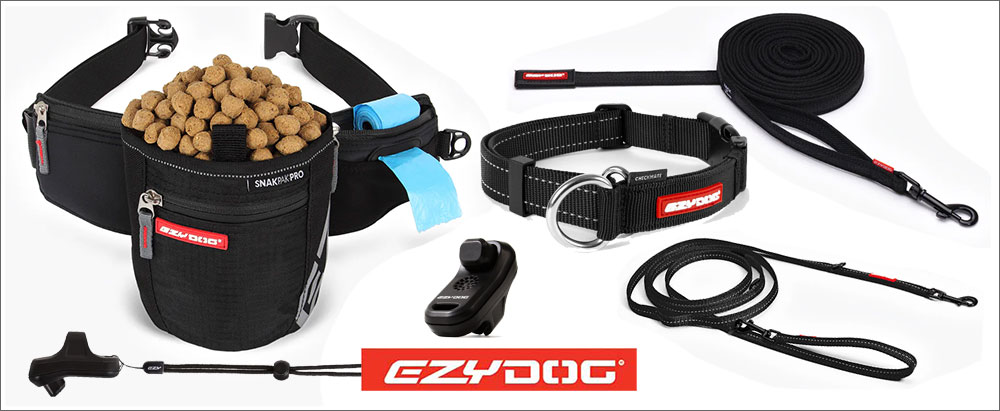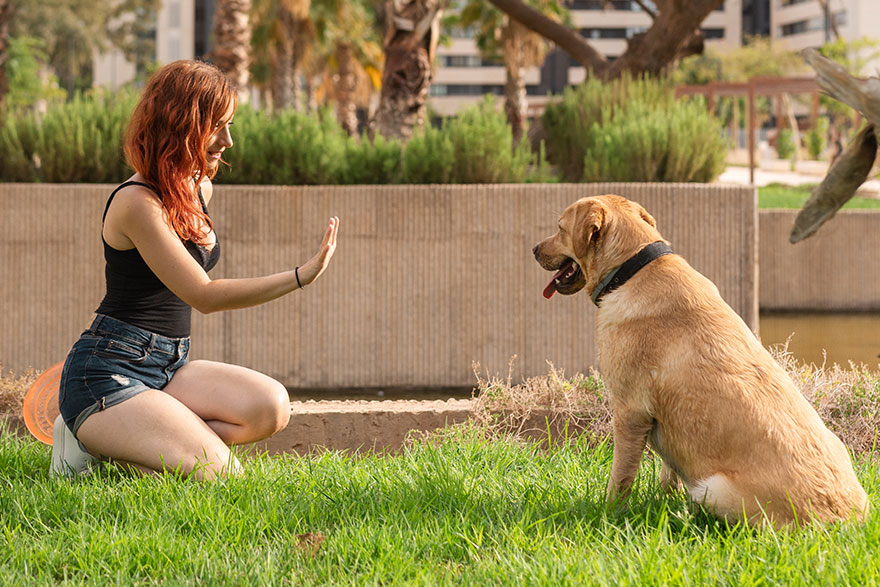
Stay Command (Dog Training Command 5)
- Share
- Share
- Share
- Share
How to Teach Your Dog to Stay Using The ‘Stay Command’.
Now that you can get your dog’s attention by calling his/her name, and your dog can sit and lay down on command, it’s time to keep them in both of those positions for an extended period of time, or more importantly, until you ‘release’ them with another command such as ‘Come’.
Having control of your dog is not only a responsibility for all dog owners, it’s how the strongest bond between you is formed. Owners of larger breed dogs need to be especially vigilant with who’s around when their dog is off their leash, so it’s important that if you foresee a potential problem, you can command your pooch to stay put, either sitting or lying down, and they will obey your command without hesitation. As far as importance goes, this instruction could also save their life, such as in hazardous road traffic situations.
This basic command, part of the series on training commands for dogs will teach you how to train your dog to stay stationary, either in the ‘sit’ or ‘down’ position using the ‘Stay Command‘ by applying positive reinforcement training techniques.
The following list is what we recommend you have handy for this dog training command session:
- Small sized, soft treats that are very tempting
- Clicker
- Collar
- Training Leash, 5-10 Metres (16-32 Foot)
- Small quiet space with no distractions
If you don’t have, or prefer not to use a ‘clicker’, you can substitute it by using the word ‘yes’.

Dog training essentials available from Ezydog Australia
Steps to Teaching the ‘Stay Command’
When teaching this basic dog training command, I will assume you’ve already taught your dog to come, sit and lay down. If not, these can be found by visiting ‘List of Dog Commands‘.
The reason for this is, we’re going to train your dog to hold the position until released (given another command), even if he/she can’t see you all the time and with distractions present.
1/ Start with your dog sitting in front of you, about 2 metres away. With an outstretched arm and flat palm facing your dog, say ‘Stay’ using a normal voice.
Count 5 and then say ‘come’ enthusiastically. Reward with a treat and lots of praise.

2/ Repeat this but after using the ‘Stay Command’ step back to 4 metres, still facing your dog. Stand still and after 10 seconds, call your dog to you again.
3/ Keep repeating this exercise, each time increasing the distance and the time you wait before ‘releasing’ your dog with the ‘Come Command’.
A ‘release cue’ is essential because you’re teaching your dog to wait patiently until he/she hears it. When your dog does come back to you, reward and praise with joy in your voice.

4/ Gradually build up the time to a minute, and the distance to at least 25 metres.
If your dog gets fidgety or walks away, return to closer distances and smaller wait times, then build both up again.
Remember to keep your training sessions to about 10 minutes. You can always practice again later in the day, or the next.
5/ Practice this again, but have your dog lay down to start with. This is going to be the position you’ll be using in practical, real-life situations, at a cafe for example.
To make the command really useful, re-teach in a variety of different environments until your dog understands that the word ‘stay’ means the same wherever they are, and that they should stay in the position until released with another command, typically ‘come’.
Summary of Teaching Your Dog The ‘Stay Command’
Remember consistency, practice and patience are the keys with all dog training. To start with, as distance and time spans increase, it may be necessary to repeat the command if you see your dog getting up. Ultimately however, you should aim to say it once to have your four-legged friend stay put and not move, despite any distraction, however close he/she may be to you, until you command otherwise.
Some dogs that aren’t overly motivated by food treats (rare) will almost certainly take to cooked chicken pieces. However, I would strongly suggest finding a commercial option that works because apart from the expense, chicken is messy and doesn’t last very long out of a sealed container in the fridge. There are many brands and flavours to choose from these days, and many are made with healthy natural ingredients. I would also suggest using and rotating several different types, so your dog doesn’t become used to just one.
As I mentioned above, using a training leash of between 5-10 metres is ideal. These leashes are used extensively for ‘track and trace’ dog training disciplines so are readily available.
Most pet shops, which you can find near you, listed on Pet Directory will have these in stock.
It’s worth noting that the longer leash isn’t to reel your dog in if they ignore you, but to control the situation. As you walk, simply gather up the leash, getting closer to your dog. Slowly give your furry companion more distance each time, before calling their name and commanding them to sit, lay down and stay.
This command is ideal to use when out for a walk and people with other dogs are approaching, especially smaller dogs if your dog is larger. The ‘submissive’ position will be less intimidating. Public places, especially in environments with other dogs is a good place to practice having your dog staying in either a sit or lying position, next to you.
Having trouble, or have a question about getting your dog to stay put when commanded?
Leave a comment for ‘Bear’ below and he’ll be happy to answer it for you, especially if you get his attention by using his name.
We at PetsBook also recommend getting out with your dog and join a training course.
Pet Directory has many local dog training businesses listed near you with experienced and accredited dog trainers ready to help you with dog obedience and dog command training.
» List of Dog Training Commands

Hi, I’m Bear, the Training Manager at PetsBook. With over 20 years experience using positive reinforcement dog training techniques, I’m proud to have the opportunity to help you develop a stronger bond with your fur baby, by teaching you useful commands with obedience training.
- Cat Behaviour & Training 1
- Cat Care 1
- Cat Health 1
- Cats 3
- Dog Behaviour & Training 38
- Dog Care 1
- Dog Grooming 2
- Dog Health 1
- Dogs 42
After A Product or Service for Your Pet?
PetsBook's Pet Directory is the easy way to find everything you need to take care of your 'fur baby'.
ABN: 97 675 528 953








